Revealing Antioxidant Activity of Cellooligosaccharides and Xylooligosaccharides from Banana Leaves, Pseudostem and Guava Seed Cake
Abstract
1. Introduction
2. Materials and Methods
2.1. Sample Preparation
2.2. Chemical Characterization of Biomass and Pretreated Material
2.3. Alkaline Pretreatment
2.4. Enzymatic Activity of Endoglucanase and Endoxylanase
2.5. COS and XOS Production by Enzymatic Hydrolysis
2.6. Determination of Monosaccharides and Acetic Acid
2.7. Determination of COS and XOS
2.8. DPPH Free-Radical Scavenging Assay
2.9. Determination of Phenolic Compounds by the Folin–Ciocalteu Method
2.10. Determination of Phenolic Compounds by Scanning Spectrophotometer
2.11. NMR Analysis
3. Results and Discussion
3.1. Chemical Composition
3.2. XOS and COS Production Yield
3.3. DPPH Scavenging Assay
3.4. Antioxidant Compound Identification
RMN Analysis
4. Conclusions
Author Contributions
Funding
Data Availability Statement
Acknowledgments
Conflicts of Interest
References
- Fuso, A.; Dejonghe, W.; Cauwenberghs, L.; Rosso, G.; Rosso, F.; Manera, I.; Caligiani, A. DPPH radical scavenging activity of xylo-oligosaccharides mixtures of controlled composition: A step forward in understanding structure–activity relationship. J. Funct. Foods 2023, 101, 105417. [Google Scholar] [CrossRef]
- Khan, F.; Kumar Garg, V.; Kumar Singh, A.; Tinku, T. Role of free radicals and certain antioxidants in the management of huntington’s disease: A review. J. Anal. Pharm. Res. 2018, 7, 291–309. [Google Scholar] [CrossRef]
- Klran, T.R.; Otlu, O.; Karabulut, A.B. Oxidative stress and antioxidants in health and disease. J. Lab. Med. 2023, 47, 1–11. [Google Scholar] [CrossRef]
- Malcangi, G.; Patano, A.; Ciocia, A.M.; Netti, A.; Viapiano, F.; Palumbo, I.; Trilli, I.; Guglielmo, M.; Inchingolo, A.D.; Dipalma, G.; et al. Benefits of Natural Antioxidants on Oral Health. Antioxidants 2023, 12, 1309. [Google Scholar] [CrossRef]
- Xu, T.; Sun, R.; Zhang, Y.; Zhang, C.; Wang, Y.; Wang, Z.A.; Du, Y. Recent Research and Application Prospect of Functional Oligosaccharides on Intestinal Disease Treatment. Molecules 2022, 27, 7622. [Google Scholar] [CrossRef]
- Chaudhary, P.; Janmeda, P.; Docea, A.O.; Yeskaliyeva, B.; Razis, A.F.A.; Modu, B.; Calina, D.; Sharifi-Rad, J. Oxidative stress, free radicals and antioxidants: Potential crosstalk in the pathophysiology of human diseases. Front. Chem. 2023, 11, 1158198. [Google Scholar] [CrossRef] [PubMed]
- Rahaman, M.M.; Hossain, R.; Herrera-Bravo, J.; Islam, M.T.; Atolani, O.; Adeyemi, O.S.; Owolodun, O.A.; Kambizi, L.; Daştan, S.D.; Calina, D.; et al. Natural antioxidants from some fruits, seeds, foods, natural products, and associated health benefits: An update. Food Sci. Nutr. 2023, 11, 1657–1670. [Google Scholar] [CrossRef]
- Phaniendra, A.; Jestadi, D.B.; Periyasamy, L. Free Radicals: Properties, Sources, Targets, and Their Implication in Various Diseases. Indian J. Clin. Biochem. 2015, 30, 11–26. [Google Scholar] [CrossRef] [PubMed]
- Sharifi-Rad, M.; Anil Kumar, N.V.; Zucca, P.; Varoni, E.M.; Dini, L.; Panzarini, E.; Rajkovic, J.; Tsouh Fokou, P.V.; Azzini, E.; Peluso, I.; et al. Lifestyle, Oxidative Stress, and Antioxidants: Back and Forth in the Pathophysiology of Chronic Diseases. Front. Physiol. 2020, 11, 694. [Google Scholar] [CrossRef] [PubMed]
- Wang, X.Q.; Wang, W.; Peng, M.; Zhang, X.Z. Free radicals for cancer theranostics. Biomaterials 2021, 266, 120474. [Google Scholar] [CrossRef]
- Pham-Huy, L.A.; He, H.; Pham-Huy, C. Free Radicals, Antioxidants in Disease and Health. Int. J. Biomed. Sci. 2008, 4, 89–96. [Google Scholar] [CrossRef]
- Perimenis, A.; Nicolay, T.; Leclercq, M.; Gerin, P.A. Comparison of the acidogenic and methanogenic potential of agroindustrial residues. Waste Manag. 2018, 72, 178–185. [Google Scholar] [CrossRef]
- El Babili, F.; Nigon, C.; Lacaze, L.; Millé, J.; Masiala, A.; Simm, J.; Lamade, V.M.; El Haj, A.A. A New Colorimetric DPPH Radical Scavenging Activity Method: Comparison with Spectrophotometric Assay in Some Medicinal Plants Used in Moroccan Pharmacopoeia. Pharmaceut Fronts. 2022, 4, 89–102. [Google Scholar] [CrossRef]
- Hajam, Y.A.; Rani, R.; Ganie, S.Y.; Sheikh, T.A.; Javaid, D.; Qadri, S.S.; Pramodh, S.; Alsulimani, A.; Alkhanani, M.F.; Harakeh, S.; et al. Oxidative Stress in Human Pathology and Aging: Molecular Mechanisms and Perspectives. Cells 2022, 11, 552. [Google Scholar] [CrossRef] [PubMed]
- Huang, C.; Wang, X.; Liang, C.; Jiang, X.; Yang, G.; Xu, J.; Yong, Q. A sustainable process for procuring biologically active fractions of high-purity xylooligosaccharides and water-soluble lignin from Moso bamboo prehydrolyzate. Biotechnol. Biofuels 2020, 12, 189. [Google Scholar] [CrossRef]
- Takatsuka, M.; Goto, S.; Kobayashi, K.; Otsuka, Y.; Shimada, Y. Evaluation of pure antioxidative capacity of antioxidants: ESR spectroscopy of stable radicals by DPPH and ABTS assays with singular value decomposition. Food Biosci. 2022, 48, 101714. [Google Scholar] [CrossRef]
- Gulcin, İ.; Alwasel, S.H. DPPH Radical Scavenging Assay. Processes 2023, 11, 2248. [Google Scholar] [CrossRef]
- Fernandes, É.S.; Bueno, D.; Pagnocca, F.C.; Brienzo, M. Minor Biomass Particle Size for an Efficient Cellulose Accessibility and Enzymatic Hydrolysis. ChemistrySelect 2020, 5, 7627–7631. [Google Scholar] [CrossRef]
- Brienzo, M.; Abud, Y.; Ferreira, S.; Corrales, R.C.; Ferreira-Leitão, V.S.; de Souza, W.; Sant’aNna, C. Characterization of anatomy, lignin distribution, and response to pretreatments of sugarcane culm node and internode. Ind. Crops Prod. 2016, 84, 305–313. [Google Scholar] [CrossRef]
- Forsan, C.F.; de Freitas, C.; Brienzo, M. Cello-oligosaccharides and Xylooligosaccharides Production by a Combination of Mechanical, Chemical, and Enzymatic Treatments of Banana Pseudostem and Leaves and Guava Bagasse. Bioenergy Res. 2024, 17, 129–144. [Google Scholar] [CrossRef]
- de Freitas, C.; Terrone, C.C.; Masarin, F.; Carmona, E.C.; Brienzo, M. In vitro study of the effect of xylooligosaccharides obtained from banana pseudostem xylan by enzymatic hydrolysis on probiotic bacteria. Biocatal. Agric. Biotechnol. 2021, 33, 101973. [Google Scholar] [CrossRef]
- Bailey, M.J.; Biely, P.; Poutanen, K. Interlaboratory testing of methods for assay of xylanase activity. J. Biotechnol. 1992, 23, 257–270. [Google Scholar] [CrossRef]
- Forsan, C.F.; De Freitas, C.; Masarin, F.; Brienzo, M. Xylooligosaccharide production from sugarcane bagasse and leaf using Aspergillus versicolor endoxylanase and diluted acid. Biomass Convers. Biorefin. 2021, 13, 3375–3390. [Google Scholar] [CrossRef]
- de Freitas, C.; Brienzo, M. Enzymatic Hydrolysis Applied to Banana Pseudostem Biomass Compared to Solubilized Xylan for Xylooligosaccharides Production with High Substrate Concentration. Bioenergy Res. 2023, 16, 1040–1050. [Google Scholar] [CrossRef]
- Lalhminghlui, K.; Jagetia, G.C. Evaluation of the free-radical scavenging and antioxidant activities of Chilauni, Schima wallichii Korth in vitro. Futur. Sci. OA 2018, 4, FSO272. [Google Scholar] [CrossRef] [PubMed]
- Singleton, V.L.; Rossi, J.A. Colorimetry of Total Phenolics with Phosphomolybdic-Phosphotungstic Acid Reagents. Am. J. Enol. Vitic. 1965, 16, 144–158. [Google Scholar] [CrossRef]
- Richard, E.N. Pre-treatment of banana leaves with alkaline banana winery bottle-washing wastewater to improve the anaerobic digestion process. Biomass Convers Biorefin. 2024, 14, 7103–7110. [Google Scholar] [CrossRef]
- Singh, A.; Kushwaha, A.; Sen, S.; Goswami, S.; Katiyar, S.; Kumar, A.; Borah, S.N.; Goswami, L.; Hussain, C.M. Chapter 7-Recent advancement in microwave-assisted pyrolysis for biooil production. In Waste-to-Energy Approaches Towards Zero Waste; Hussain, C.M., Singh, S., Goswami, L., Eds.; Elsevier: Amsterdam, The Netherlands, 2022; pp. 197–219. [Google Scholar]
- Bueno, D.; de Freitas, C.; Brienzo, M. Enzymatic Cocktail Formulation for Xylan Hydrolysis into Xylose and Xylooligosaccharides. Molecules 2023, 28, 624. [Google Scholar] [CrossRef]
- Melati, R.B.; Shimizu, F.L.; Oliveira, G.; Pagnocca, F.C.; de Souza, W.; Sant’aNna, C.; Brienzo, M. Key Factors Affecting the Recalcitrance and Conversion Process of Biomass. Bioenergy Res. 2019, 12, 1–20. [Google Scholar] [CrossRef]
- Shimizu, F.L.; de Azevedo, G.O.; Coelho, L.F.; Pagnocca, F.C.; Brienzo, M. Minimum Lignin and Xylan Removal to Improve Cellulose Accessibility. Bioenergy Res. 2020, 13, 775–785. [Google Scholar] [CrossRef]
- Fernandes, L.P.; Ventorim, R.Z.; de Oliveira, M.G.; Almeida, L.F.; Guimarães, V.M.; Maitan-Alfenas, G.P. Xylooligosaccharides from Pretreated Rice Bran Produced by Immobilized Xylanase. Bioenergy Res. 2024, 17, 2236–2245. [Google Scholar] [CrossRef]
- Paschoa, J.L.F.; Ávila, P.F.; Ramalho, E.X.; Silva, M.F.; Bueno, D.; Goldbeck, R. Production and purification of xylooligossaccharides from sugarcane bagasse and antioxidant potential assessment for functional ingredient application in the food industry. Ind. Crop. Prod. 2024, 208, 117844. [Google Scholar] [CrossRef]
- Victoria Gautério, G.; Amorim, C.; Silvério, S.C.; Cardoso, B.B.; Ballesteros, L.F.; Alves, J.I.; Pereira, M.A.; Silva, S.P.; Coelho, E.; Coimbra, M.A.; et al. Hydrolysates containing xylooligosaccharides produced by different strategies: Structural characterization, antioxidant and prebiotic activities. Food Chem. 2022, 391, 133231. [Google Scholar] [CrossRef]
- Gowdhaman, D.; Ponnusami, V. Production and optimization of xylooligosaccharides from corncob by Bacillus aerophilus KGJ2 xylanase and its antioxidant potential. Int. J. Biol. Macromol. 2015, 79, 595–600. [Google Scholar] [CrossRef]
- Valls, C.; Pastor, F.I.J.; Vidal, T.; Roncero, M.B.; Díaz, P.; Martínez, J.; Valenzuela, S.V. Antioxidant activity of xylooligosaccharides produced from glucuronoxylan by Xyn10A and Xyn30D xylanases and eucalyptus autohydrolysates. Carbohydr. Polym. 2018, 194, 43–50. [Google Scholar] [CrossRef]
- Ávila, P.F.; Martins, M.; de Almeida Costa, F.A.; Goldbeck, R. Xylooligosaccharides production by commercial enzyme mixture from agricultural wastes and their prebiotic and antioxidant potential. Bioact. Carbohydr. Diet. Fibre 2020, 24, 100234. [Google Scholar] [CrossRef]
- Xu, X.; Deng, G.; Li, X.; Li, P.; Chen, T.; Zhou, L.; Huang, Y.; Yuan, M.; Ding, C.; Feng, S. Extraction, Structural, and Antioxidant Properties of Oligosaccharides Hydrolyzed from Panax notoginseng by Ultrasonic-Assisted Fenton Degradation. Int. J. Mol. Sci. 2023, 24, 4506. [Google Scholar] [CrossRef]
- Bian, J.; Peng, F.; Peng, X.P.; Peng, P.; Xu, F.; Sun, R.-C. Structural features and antioxidant activity of xylooligosaccharides enzymatically produced from sugarcane bagasse. Bioresour. Technol. 2013, 127, 236–241. [Google Scholar] [CrossRef]
- Silverstein, R.M.; Webster, F.X.; Kiemle, D.J.; Bryce, D.L. Spectrometric Identification of Organic Compounds, 8th ed.; John Wiley & Sons: Hoboken, NJ, USA, 2014. [Google Scholar]
- Imman, S.; Khongchamnan, P.; Wanmolee, W.; Laosiripojana, N.; Kreetachat, T.; Sakulthaew, C.; Chokejaroenrat, C.; Suriyachai, N. Fractionation and characterization of lignin from sugarcane bagasse using a sulfuric acid catalyzed solvothermal process. RSC Adv. 2021, 11, 26773–26784. [Google Scholar] [CrossRef] [PubMed]
- Sun, Y.; Cui, S.W.; Gu, X.; Zhang, J. Isolation and structural characterization of water unextractable arabinoxylans from Chinese black-grained wheat bran. Carbohydr. Polym. 2011, 85, 615–621. [Google Scholar] [CrossRef]
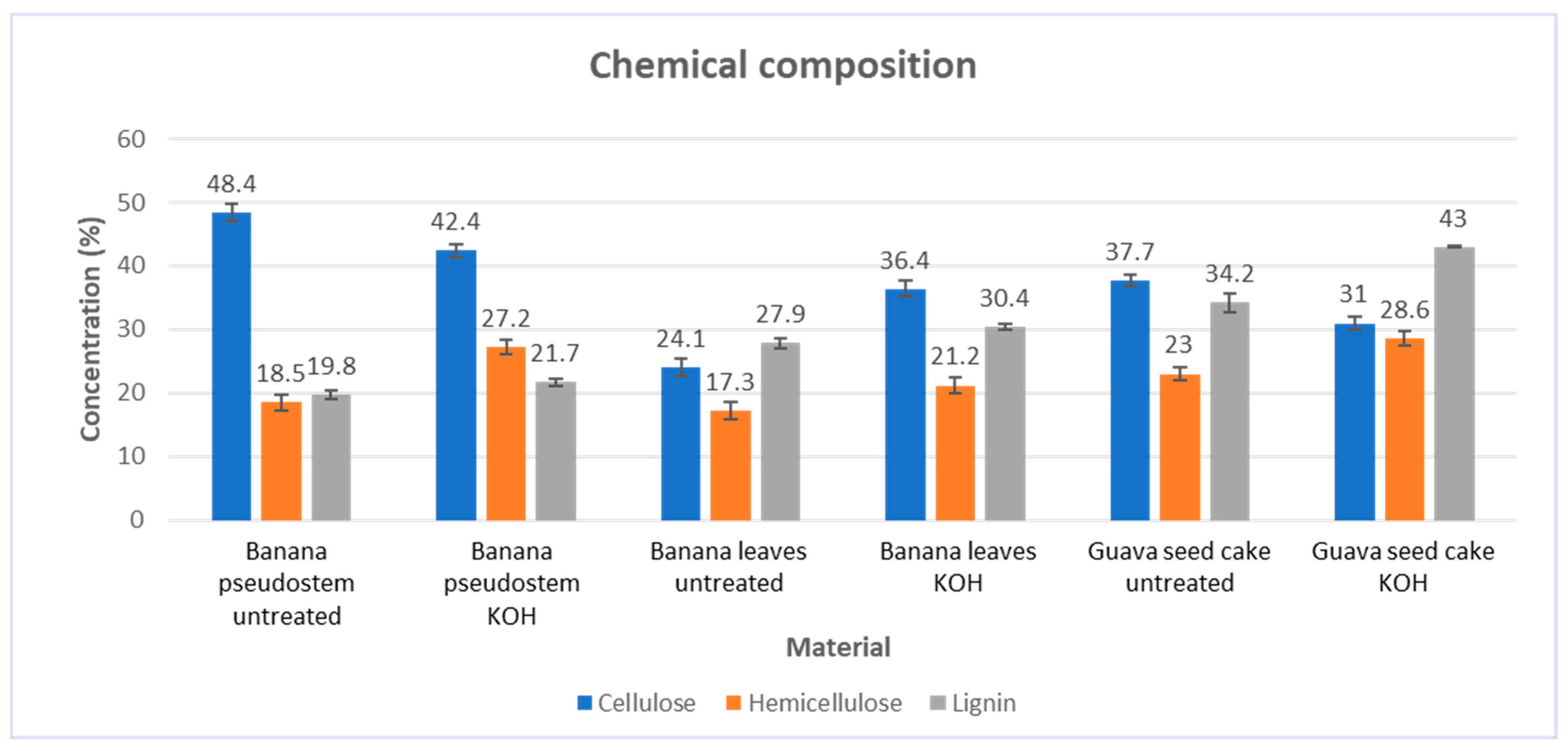
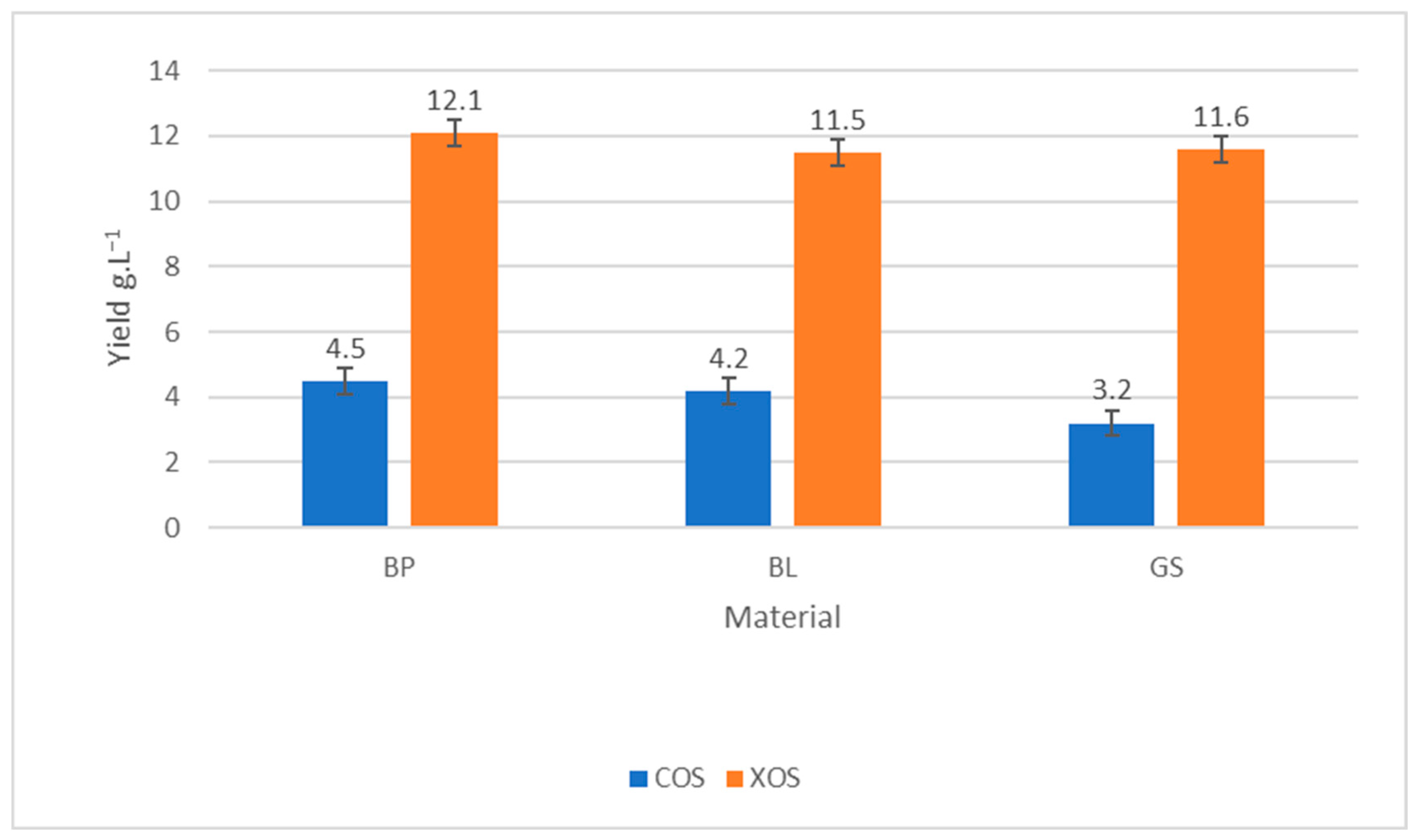
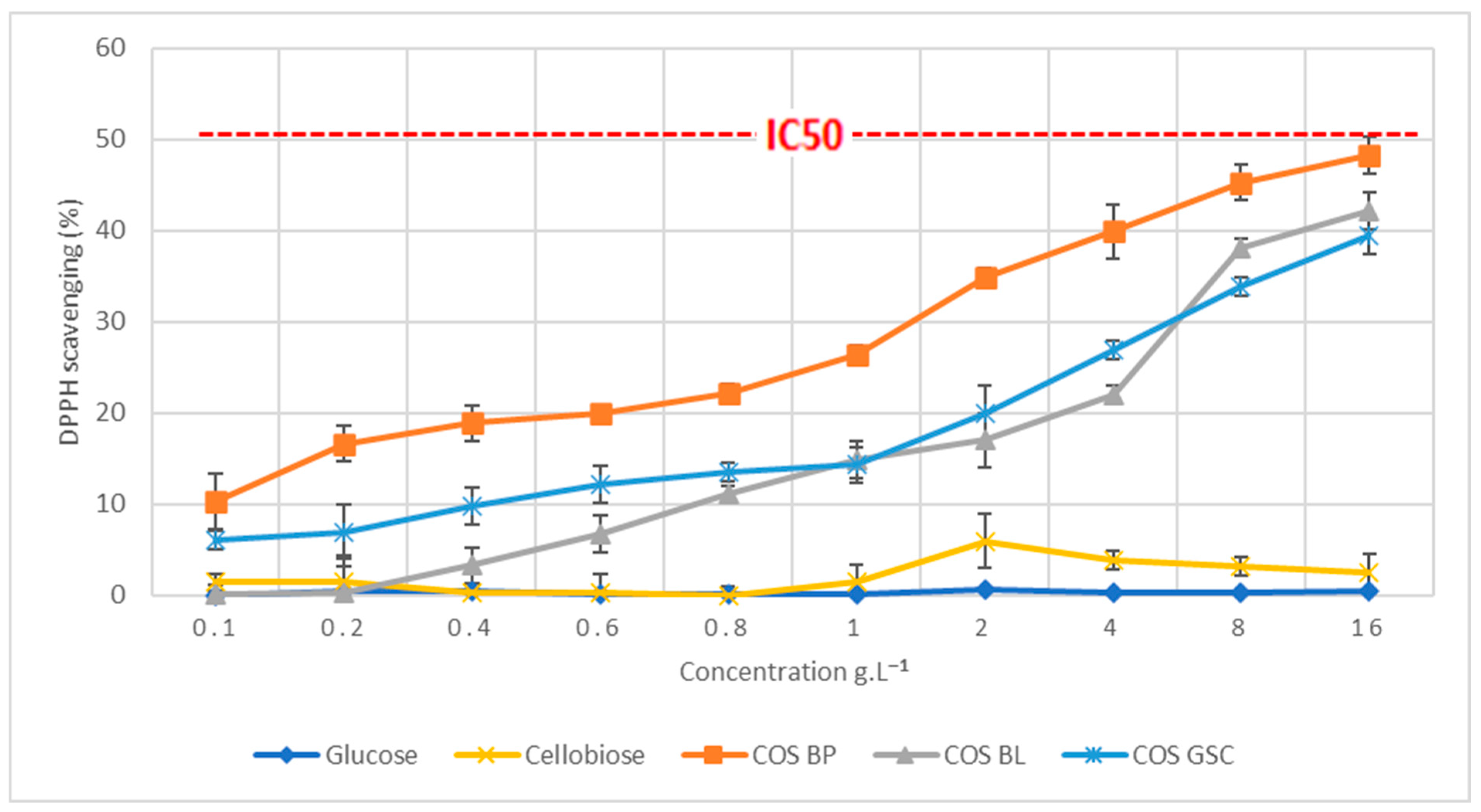

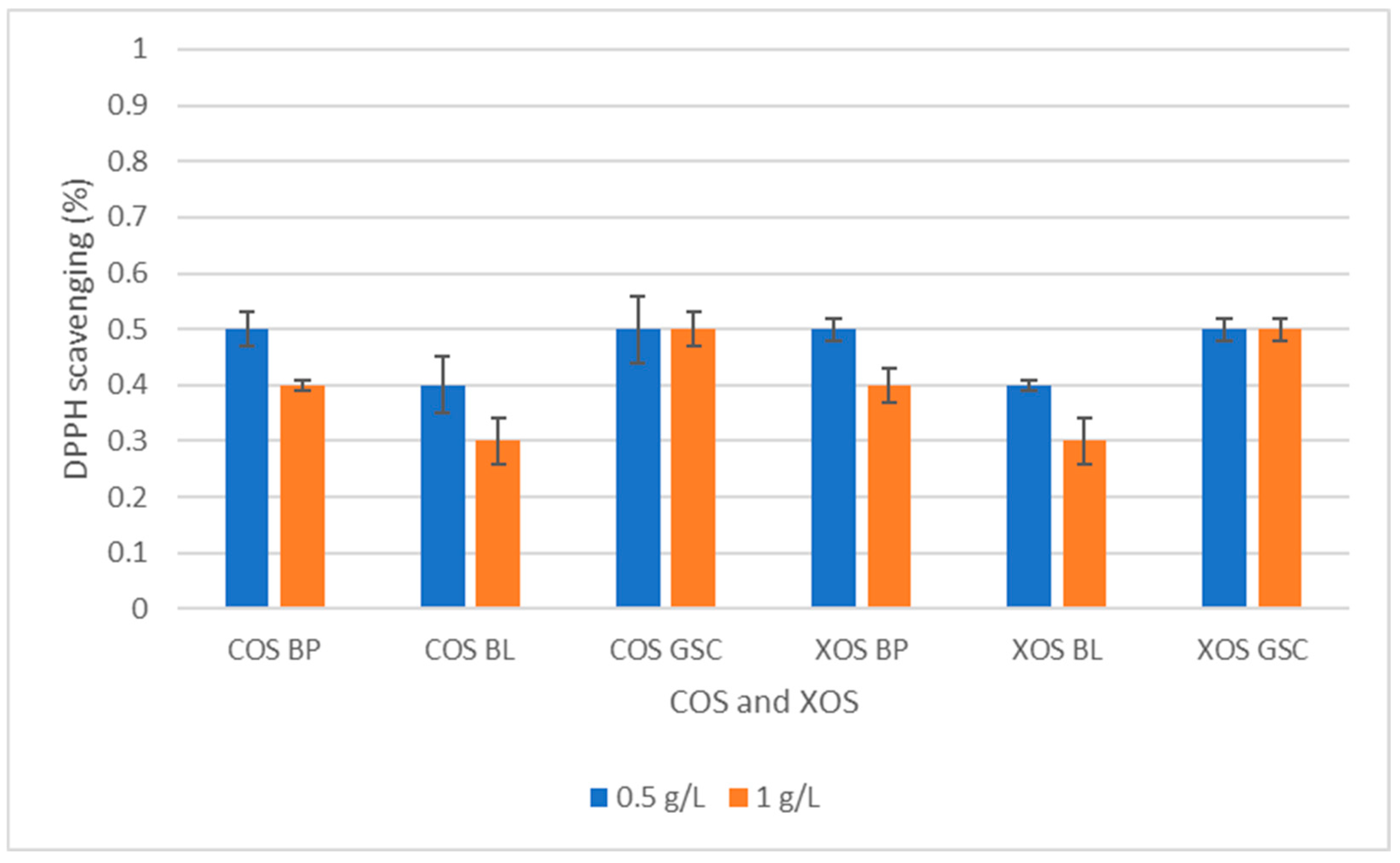
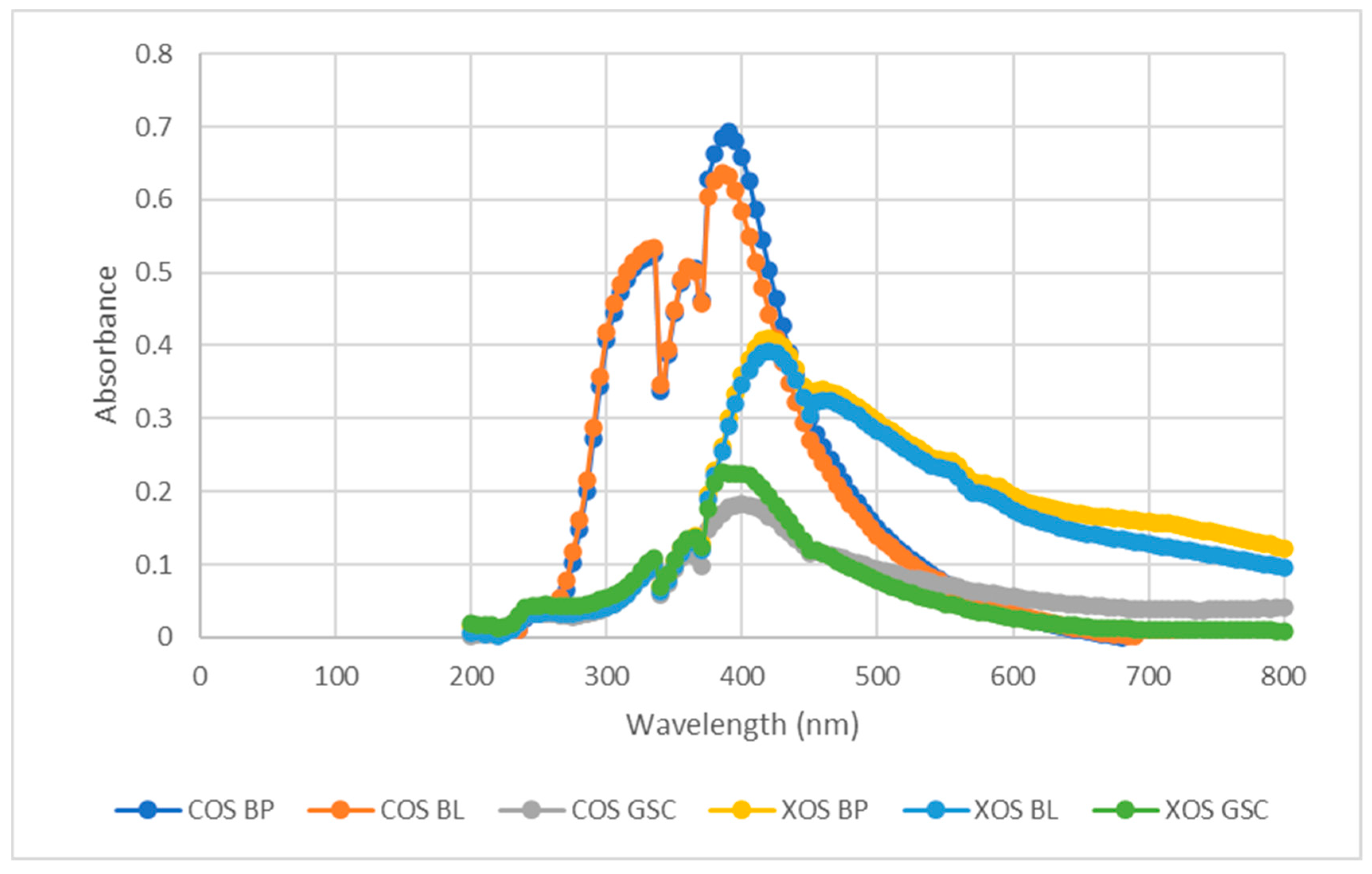

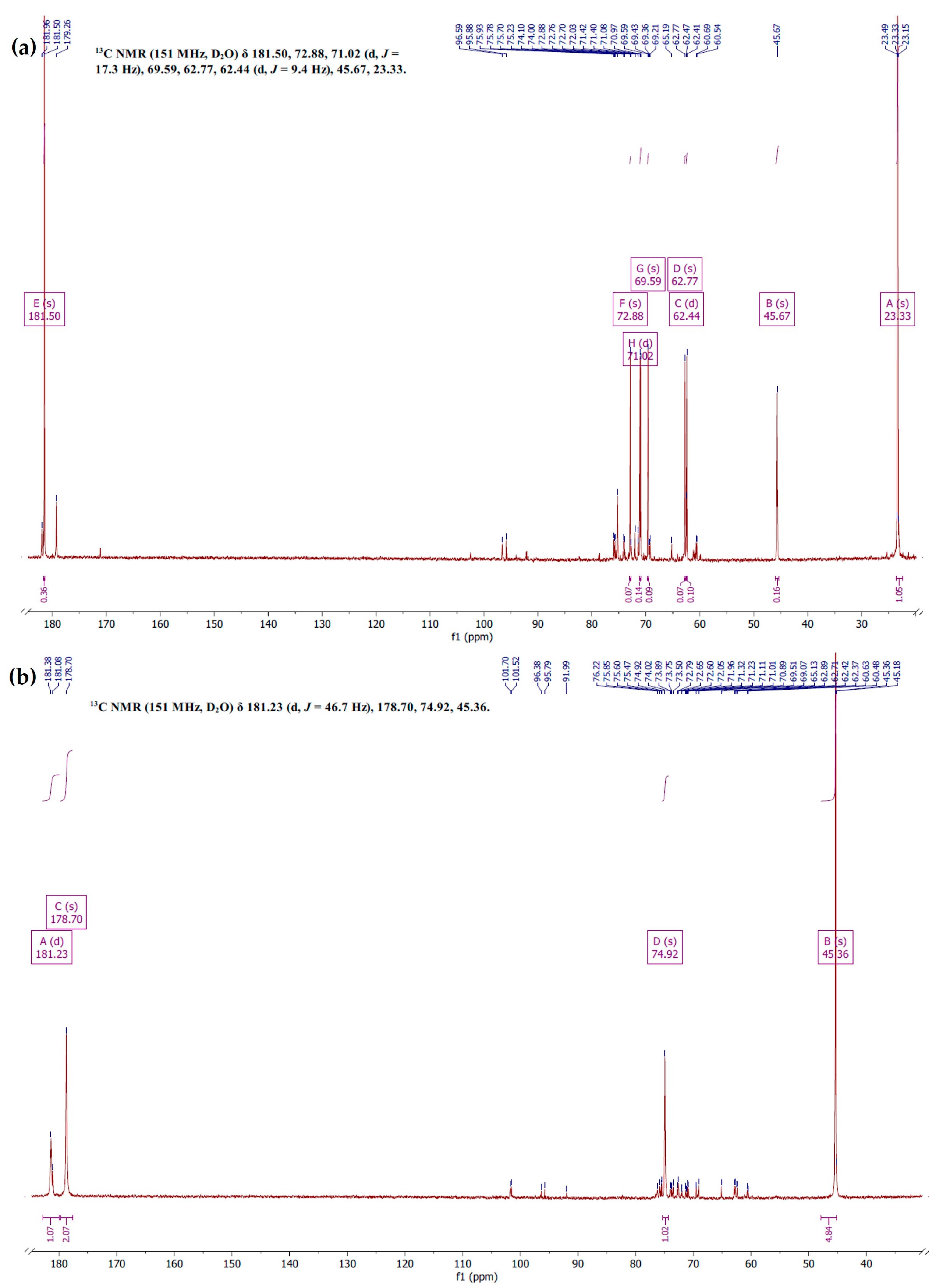
| Material | TPC (μg GAE/mg COS or XOS) | DPPH IC50 Values (g·L−1) |
|---|---|---|
| COS BP | 3.47 ± 0.21 | - |
| COS BL | 3.70 ± 0.39 | - |
| COS GSC | 2.61 ± 0.27 | - |
| XOS BP | 4.97 ± 0.48 | 8.0 ± 0.8 |
| XOS BL | 3.86 ± 0.14 | 6.2 ± 0.6 |
| XOS GSC | 5.55 ± 0.58 | 4.1 ± 0.3 |
| Samples | Spectral Signals (nm) |
|---|---|
| COS BP | 335, 360, 390 |
| COS BL | 335, 360, 385 |
| COS GSC | 335, 400, 455 |
| XOS BP | 335, 420, 460 |
| XOS BL | 335, 420 |
| XOS GSC | 335, 385 |
| Soluble lignin from banana pseudostem | 290, 385, 450, 570, 605 |
| Extractives | 315, 360, 385, 570 |
| Galic acid | 290, 385, 450 |
| Sodium acetate buffer + Celluclast | 280 |
| Sodium phosphate buffer + Aspergillus versicolor endoxylanase | 270 |
| Cellobiose | 290, 315 |
Disclaimer/Publisher’s Note: The statements, opinions and data contained in all publications are solely those of the individual author(s) and contributor(s) and not of MDPI and/or the editor(s). MDPI and/or the editor(s) disclaim responsibility for any injury to people or property resulting from any ideas, methods, instructions or products referred to in the content. |
© 2025 by the authors. Licensee MDPI, Basel, Switzerland. This article is an open access article distributed under the terms and conditions of the Creative Commons Attribution (CC BY) license (https://creativecommons.org/licenses/by/4.0/).
Share and Cite
Forsan, C.F.; Marin, D.F.C.; Brienzo, M. Revealing Antioxidant Activity of Cellooligosaccharides and Xylooligosaccharides from Banana Leaves, Pseudostem and Guava Seed Cake. AppliedChem 2025, 5, 21. https://doi.org/10.3390/appliedchem5030021
Forsan CF, Marin DFC, Brienzo M. Revealing Antioxidant Activity of Cellooligosaccharides and Xylooligosaccharides from Banana Leaves, Pseudostem and Guava Seed Cake. AppliedChem. 2025; 5(3):21. https://doi.org/10.3390/appliedchem5030021
Chicago/Turabian StyleForsan, Carolina Froes, Danieli Fernanda Canaver Marin, and Michel Brienzo. 2025. "Revealing Antioxidant Activity of Cellooligosaccharides and Xylooligosaccharides from Banana Leaves, Pseudostem and Guava Seed Cake" AppliedChem 5, no. 3: 21. https://doi.org/10.3390/appliedchem5030021
APA StyleForsan, C. F., Marin, D. F. C., & Brienzo, M. (2025). Revealing Antioxidant Activity of Cellooligosaccharides and Xylooligosaccharides from Banana Leaves, Pseudostem and Guava Seed Cake. AppliedChem, 5(3), 21. https://doi.org/10.3390/appliedchem5030021






